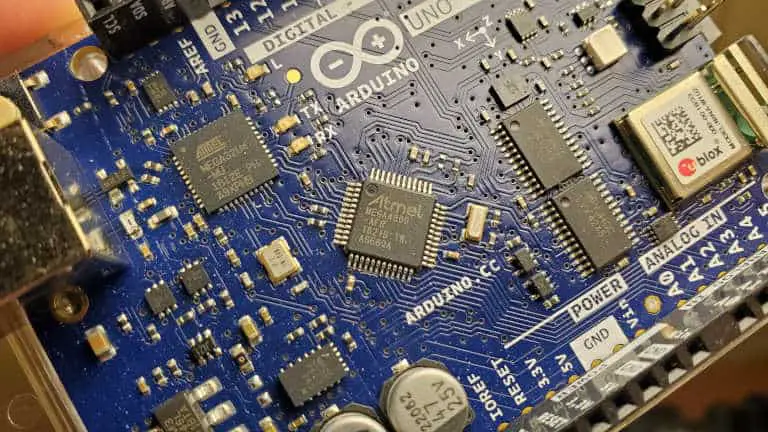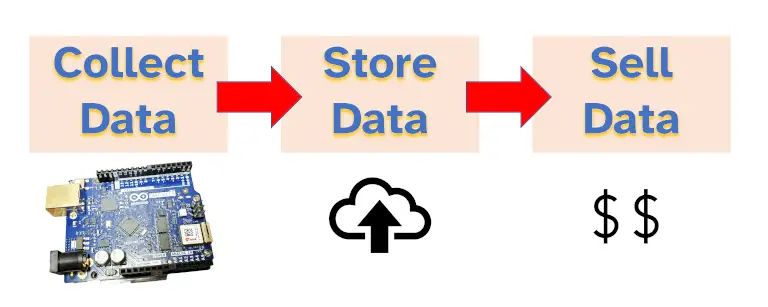I put together this list of ways Arduino is used in industry today (and for the foreseeable future) to help inspire anyone looking to learn Arduino. People often ask me, as an electronics engineer, what are some professional uses of Arduino. This is what I’ve included in this guide.
Arduino is typically used in the processing and manufacturing industry, typically either as a tool to improve automated processes or to control manufacturing equipment such as CNC machines. It is also a powerful prototyping device which allows electronics engineers to trial designs before arranging complex manufacturing processes for final products.

I’ve found Arduino is not typically used in electronics products themselves however. When I was coming out of uni as an electronics engineer, I found there weren’t really any products that were built with Arduino. This is because Arduino is more of a prototyping tool – if you’re curious to know what this means, in this guide below I’ve included what industry Arduino is used in and how you can explore those industries today.
1. Prototyping tool
Arduino is used in industry as part of the development of prototypes for products that are to be manufactured. By creating a prototype first using Arduino, the product development team can test the prototype with end-users to determine if it’s viable prior to costly manufacturing processes.
To use Arduino as a prototype for a product:
- Define the functions your product should accomplish
- Implement those functions with Arduino and accompanying components
- Test those functions with the intended user
Following these steps uses Arduino to quickly develop a product so that you can see if what you’re producing is helpful to your user. I like to focus on the functions of a product in my engineering work – what is that product going to do, how will my users interact with that product.
I had some friends who did this at university, they developed a prototype for a product that they’ve gone on to sell at $100 per unit! It started off as an Arduino based system to detect colour, and now it’s a full-fledged product that can be bought here.
I’ve found this is a long and difficult process though. It can take years from building a prototype to selling an actual product, and there are a lot of people that are needed to help you along the way. I reckon the other uses of Arduino in this guide are a quicker way to use Arduino in an industry.
If you’re interested in ways you can make money with Arduino, I wrote a whole guide to that here: chipwired.com/make-money-with-arduino/
2. Improving industrial processes
Arduino can be used as part of industrial manufacturing processes to control other devices and equipment.
A recent project I saw was a team at Boeing who used an Arduino to repair a particular component for a satellite. An Arduino was used to precisely control the machines milling machines used in the repair of these components.
I’ve found Arduino can be a useful tool to quickly implement a control process, even in an industrial setting. By being able to repeatedly execute code based on inputs, an Arduino is able to control industrial equipment.
To get involved with this one, I would recommend the first step after learning Arduino would be to work in manufacturing. In particular, work related to optimising manufacturing processes, or working with CNC machines, milling machines, or even 3D printers.
3. Capturing data
This is one of the ways I’ve worked with an Arduino as part of my job (I’m originally an electronics engineer, now a systems engineer).
An Arduino can be used to capture data from sensors and other inputs, and to store that data for later analysis. Sensors or other devices, such as radio receivers, can be connected to the Arduino such that the Arduino can read those inputs and then store that data. Data can be stored to SD card or uploaded to the cloud.

We used to use this to capture data of planes landing at an airport. Similar to this project on Hackaday, except the airport was paying us for the data as part of long-term optimisation planning of runways, taxiways, and general airport operations. An ADS-B receiver was attached to the Arduino, which the Arduino could communicate with, request data from, and save that data to an SD card. We collected the SD card periodically and then used that data to help improve airport operations.
Other data capture opportunities I can think of include:
- Bluetooth proximity sensors
- Weather
- Passage of vehicles (I explored using Arduino on a train line once)
- Operation of machinery (e.g. how often a machine does an action)
4. Manufacturing using 3D printers or CNC machines
Arduino can be used to manufacture products by controlling 3D printers, CNC machines, milling machines and similar equipment.
One of my father’s first Arduino projects was to control a CNC machine. He wanted to use it to build wooden railway tracks as a toy. He spent a lot of time fine-tuning the setup and was eventually able to product a high quality set of wooden railway tracks.
There is an industry around producing parts using CNC machines and 3D printers. An Arduino can be beneficial in this industry when it’s used to control these machines.
Another example I found was a someone who 3D printed custom motorcycle parts which were incredibly difficult to get in his country.
5. Education
Arduino is a powerful teaching tool. Its simplicity means it can be used to teach electronics, coding, robotics, computer science, and other similar disciplines. I like to think of it as what you build is what you get – it’s very obvious how your actions of code and circuitry turn into something that works.
I’ve found Arduino used in an education setting to teach:
- Internet of Things
- Embedded System Design
- C Programming
- Wiring of circuits
- Circuit design
- Control of motors and other devices
While I’ve seen these topics covered using other devices, such as Raspberry Pi, the simplicity of Arduino means it’s a great tool to introduce these concepts.
Arduino even has a whole section on their website dedicated to teaching material for young people. There’s plenty of material here too if you’re getting into Arduino at an older age.
Bottom Line
Arduino is still relevant in industry despite being a simple microprocessor. Its simplicity to work with means there are many opportunities to develop something quickly with an Arduino, whether that be a lesson, a prototype of a product, or even a data capture facility.
I believe Arduino will continue to be relevant well into the future!
Chris is an electronics engineer who once tried to develop a prototype electronics device at university. It didn’t work out, but he did see some classmates become successful developing theirs.
